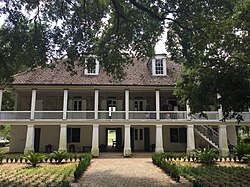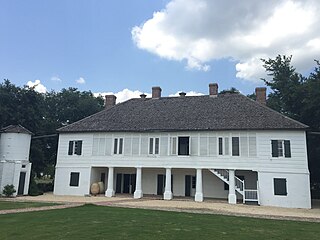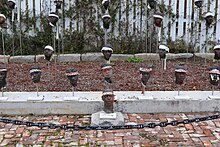Whitney Plantation Historic District
Whitney Plantation Historic District | |
 Front of the Big House | |
 | |
| Nearest city | Wallace, Louisiana |
|---|---|
| Coordinates | 30°2′21″N 90°39′2″W / 30.03917°N 90.65056°WCoordinates: 30°2′21″N 90°39′2″W / 30.03917°N 90.65056°W |
| Area | 40 acres (16 ha) |
| Built | 1803 |
| Architectural style | Federal, French Creole |
| Website | whitneyplantation |
| MPS | Louisiana's French Creole Architecture MPS |
| NRHP reference No. | 92001566[1] |
| Added to NRHP | November 24, 1992[2][3] |
The Whitney Plantation Historic District is a museum devoted to slavery in the Southern United States. The district, including the main house and outbuildings, is preserved near Wallace, in St. John the Baptist Parish, Louisiana, on the River Road along the Mississippi River. The plantation was started in 1752 by German immigrants Ambroise Haydel and his wife. Their descendants owned it until 1867,[4] when it was sold to businessman Bradish Johnson and renamed after one of his daughters, Whitney.[5]
Overview[]
The plantation is a 2,000-acre property, mainly occupied by the museum[4] which opened to the public for the first time in December 2014. It was founded by John Cummings, a trial attorney from New Orleans who has spent more than $8 million of his own fortune on this long-term project, and worked on it for nearly 15 years.[6][7] The director of research is Dr. Ibrahima Seck, a Senegalese scholar specializing in the history of slavery.[4] The grounds contain imaginative exhibits and original art commissioned by Cummings, such as life-size sculptures of children. The sculptures are representative of people born into slavery before the Civil War, many of whom were interviewed as adults for the Federal Writers Project during the Great Depression. These oral histories of hundreds of the last survivors of slavery in the United States were collected and published by the federal government, to preserve their stories. The transcripts and some audio recordings are held by the Library of Congress.[8][4]
The French Creole raised-style[2][3] main house, built in 1803, is the most important architectural example in the state. The plantation has numerous outbuildings or "dependencies": a pigeonnier or dovecote, a plantation store, the only surviving French Creole barn in Louisiana, and slave quarters. The quarters were moved from another plantation but are typical of the those originally on Whitney.[9] The complex includes three archaeological sites[2][3] which have had varying degrees of exploration.
The 1884 Mialaret House, and its associated buildings and property, were added to the complex by later purchase. They help to reflect the long working history of the plantation.[9] Some of the extensive land is still planted with sugarcane.
The Whitney Plantation historic district was listed on the U.S. National Register of Historic Places in 1992.[2][3] It is one of 26 sites featured on the Louisiana African American Heritage Trail.

The Whitney Plantation Slave Memorials, with recorded names of many slaves

Rear of the Big House

Reconstruction of blacksmith shop run by slave Robin
In popular culture[]

Scenes from the 2012 Quentin Tarantino film Django Unchained were filmed on and around the plantation.[6] The Atlantic magazine made a short documentary video about the museum in 2015, Why America Needs a Slavery Museum.[7]
See also[]
- Evergreen Plantation, also in the vicinity of Wallace
- Louisiana African American Heritage Trail
- National Register of Historic Places listings in St. John the Baptist Parish, Louisiana
- Plantation complexes in the Southern United States
- Rural African American Museum, Opelousas
- History of slavery in Louisiana
- List of plantations in Louisiana
References[]
- ^ "National Register Information System". National Register of Historic Places. National Park Service. July 9, 2010.
- ^ a b c d "Whitney Plantation Historic District". National Historic Places Register. Retrieved August 3, 2020 – via National Register Database, Louisiana.
- ^ a b c d "National Register of Historic Places Registration Form". National Register of Historic Places. National Park Service. October 13, 1992. Retrieved August 3, 2020.
- ^ a b c d Amsden, David (February 26, 2015). "Building the First Slavery Museum in America". New York Times. Retrieved October 27, 2017.
- ^ "Ownership of the Whitney". Whitney Plantation.
- ^ a b Kaminsky, Jonathan (January 17, 2015). "Harsh world of slavery focus of Louisiana plantation museum". Reuters. Retrieved January 19, 2015.
- ^ a b Rosenfeld, Paul (August 25, 2015). "Why America Needs a Slavery Museum". The Atlantic.
- ^ "Born in Slavery: Slave Narratives from the Federal Writers' Project, 1936 to 1938". Library of Congress.
- ^ a b "Whitney Plantation Historic District". Travel Itinerary, National Park Service. National Park Service. Retrieved August 3, 2020.
External links[]
| Wikimedia Commons has media related to Whitney Plantation Historic District. |
- Official website
- Whitney Plantation museum confronts painful history of slavery. CBS This Morning. April 8, 2015. Retrieved August 3, 2020.
- Stodghill, Ron (May 25, 2008). "Driving Back Into Louisiana's History". The New York Times. Retrieved August 3, 2020.
- Houses completed in 1803
- Creole architecture in Louisiana
- Louisiana African American Heritage Trail
- Geography of St. John the Baptist Parish, Louisiana
- Historic districts on the National Register of Historic Places in Louisiana
- Sugar plantations in Louisiana
- National Register of Historic Places in St. John the Baptist Parish, Louisiana
- Slavery museums
- African-American museums in Louisiana
- Slave cabins and quarters in the United States
- Blacksmith shops




